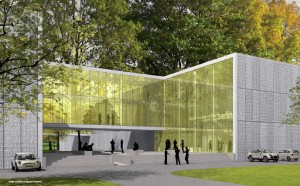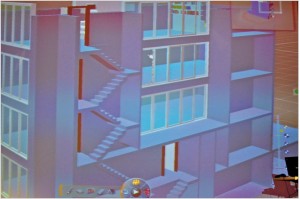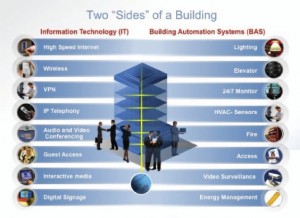Archive for category BIM
Green BIM : Everybody’s Doing It
Posted by Jim Foster in BIM, Green on October 25, 2010
 As reported recently in the Wall Street Journal, ‘Turning Consumers Green‘ the best tactic is peer pressure. From reducing plastic bag use to turning off the shower. You might ask, who’s going to pressure me in the shower. Fair enough, but this is in a locker room setting where they stated when a sign was posted to turn off the shower when soaping there was 6% compliance but if there was a plant, as in a person who they planted there to turn off water when they soaped, compliance rocketed to 47%. (Sidebar: How do they advertise this job and who applies or volunteers for that particular task.) But how does this impact you rather than reemphasizing people are sheep? Well if you can identity a trend that gains this kind of traction because of the peer pressure you don’t have to look far out into our industry before you find BIM and the emerging strength of Green BIM and rapid energy modeling. In a recent MCGraw Hill Smart Market Report, Green BIM the cited the growth of sustainable retrofits that are green will increase from 5-9% currently to 20-30% in 2014. Huge growth in energy simulation is expected in this market with the top 3 being:
As reported recently in the Wall Street Journal, ‘Turning Consumers Green‘ the best tactic is peer pressure. From reducing plastic bag use to turning off the shower. You might ask, who’s going to pressure me in the shower. Fair enough, but this is in a locker room setting where they stated when a sign was posted to turn off the shower when soaping there was 6% compliance but if there was a plant, as in a person who they planted there to turn off water when they soaped, compliance rocketed to 47%. (Sidebar: How do they advertise this job and who applies or volunteers for that particular task.) But how does this impact you rather than reemphasizing people are sheep? Well if you can identity a trend that gains this kind of traction because of the peer pressure you don’t have to look far out into our industry before you find BIM and the emerging strength of Green BIM and rapid energy modeling. In a recent MCGraw Hill Smart Market Report, Green BIM the cited the growth of sustainable retrofits that are green will increase from 5-9% currently to 20-30% in 2014. Huge growth in energy simulation is expected in this market with the top 3 being:
- Whole Building Energy Use
- Lighting and Day Lighting
- Energy Code Compliance
This type of analysis is right in BIM’s wheelhouse as seen in Revit CEA. However, one of the biggest issues still remains software integration, that is one model, many uses rather than everyone building their own model for their own uses. So look for more companies trying to either build functionality on top of existing platforms or creating translation or integration tools.
Look for Green to expand. It’s not for just Organic Folks eating Birkenstocks at their local markets as it is starting to make too much sense. For example, Casa Feliz Apartments in San Jose and as reported by Robbie Whelan in the Wall Street Journal, ‘utilized bamboo floors, linseed oil based linoleum and ergonomic chairs in the lobby made from sustainability farmed wood.’ Addtionally,
Casa Feliz is one of a growing number of affordable-housing projects nationwide that have been built “green”—that is, with nontoxic materials, highly energy-efficient appliances, and features such as green roofs and solar panels. Thanks to tax credits designed to attract private capital and aggressive cost-cutting on other construction features, affordable-housing developers are embracing eco-friendly building features that were once the purview of high-minded designers and wealthy developers with money to spare.
MetLife Inc., the big New York-based insurance company, is one of those investors. Matt Sheedy, who invests funds from MetLife’s $325 billion general account, says MetLife and other large institutional investors are eager to invest in green affordable-housing projects because they have a safer risk profile than more traditional housing projects.
So either get caught by the wave, or build your boat out of sustainable wood, hoist your hemp sail and get going. Your firm needs a Green BIM strategy.
On the heels of BIM lag in Europe Report : UK Construction Chief calls for BIM
Posted by Jim Foster in BIM on October 6, 2010
 As reported by Stephen Kennett in this article at Building.Co. UK, “Paul Morrell, the government’s chief construction adviser, has indicated that publically procured building projects will be required to adopt building information modelling.” I have included the majority of the article as it is quick read.
As reported by Stephen Kennett in this article at Building.Co. UK, “Paul Morrell, the government’s chief construction adviser, has indicated that publically procured building projects will be required to adopt building information modelling.” I have included the majority of the article as it is quick read.
The concept behind building information modelling or BIM is that everyone on the project shares the same 3D CAD model to design, build and, ultimately, run the building.
Speaking at the Autodesk BIM conference, Morrell said the move follows government research that concludes that BIM offers tangible benefits to the construction industry supply chain, and value for money to the taxpayer.
He said: “We have commissioned a team drawn from BIM users across the industry, both clients and suppliers, and software developers, to prepare a route map that shows how we can make a progressive move to the routine use of BIM. I am convinced that this is the way to unlock new ways of working that will reduce cost and add long-term value to the development and management of built assets in the public sector”.
He added that the move needs to be made on a basis that is secure, that works for government clients and those who deliver services to them, and which draws on proven means of integrating the supply chain.
The report will be released in March next year. Morrell says he “hopes and believes” it will mark the beginning of a commitment to a timed programme of transformation”.
Phil Bernstein, vice-president of Autodesk who produce a range of BIM based design tools, said the announcement was a positive step and could mark a game changer in the uptake of the technology in the UK.
“We believe that yesterday’s recommendation to UK government construction procurers will drive industry change, just as similar decisions by the government have in the US”.
However, he added that he doesn’t think the UK market is prepared for the wholesale uptake of BIM. “If this was to be adopted in the next six months then there wouldn’t be enough BIM capable practitioners to do what is being talked about however, by creating a set of requirements that will allow the UK market to adjust itself accordingly, will help greatly. A lot of practitioners can spend the next year getting ready for the change”.
Bernstein predicts that the uptake of BIM on public projects will be mirrored in the private sector.
The US through the GSA requires BIM, so that’s US Federal, states have started requiring BIM for public projects, Universities, and now the UK is on board. How BIM will be defined will be up to the lobbyists and mind share and quick search using Google Trends between Revit, Archicad, Microstation, Vectorworks, has Revit outpacing. However, add SketchUp to the mix and it dwarfs all the others. So A) The BIM train is coming and B) BIM enthusiasts mock SketchUp at your peril.
Greening the Built Environment : Autodesk joins IBM’s Green Sigma Coalition : IBM Flexing its Market Power Muscle : BIM
Posted by Jim Foster in BIM, Built Environment on October 5, 2010
 Quick jumble from IBM to BIM and it seems a lot of threads are coming together between IBM and the AECOM community. Smart Buildings and Smart Cities, IBM and Dassault, IBM Maximo, etc. How this comes to grind with LEED, and EnergyStar initiatives , etc remains to be seen but there is quite a roster to this invite only list. Charter members include: Johnson Controls, Honeywell Building Solutions, ABB, Eaton, ESS, Cisco, Siemens Building Technologies Division, Schneider Electric and SAP but nothing like owning the process and selling services, hardware, software, product to achieve Green Sigma. The process itself :
Quick jumble from IBM to BIM and it seems a lot of threads are coming together between IBM and the AECOM community. Smart Buildings and Smart Cities, IBM and Dassault, IBM Maximo, etc. How this comes to grind with LEED, and EnergyStar initiatives , etc remains to be seen but there is quite a roster to this invite only list. Charter members include: Johnson Controls, Honeywell Building Solutions, ABB, Eaton, ESS, Cisco, Siemens Building Technologies Division, Schneider Electric and SAP but nothing like owning the process and selling services, hardware, software, product to achieve Green Sigma. The process itself :
“Combines real-time metering and monitoring with advanced analytics and dashboards that allow clients to make better decisions that improve efficiency, lower costs and reduce environmental impact.”
IBM goes on to outline the validation process which is, you guessed it, validated by IBM. How this differs from LEED which:
… is an internationally recognized green building certification system, providing third-party verification that a building or community was designed and built using strategies aimed at improving performance across all the metrics that matter most: energy savings, water efficiency, CO2 emissions reduction, improved indoor environmental quality, and stewardship of resources and sensitivity to their impacts.
Now I am a capitalist so increasing shareholder value is something I take to heart, sure there’s a lot more in the mix than that and who am I to take IBM to task for flexing its market power muscle but aren’t we talking the same side of the coin only IBM wants to own the coin too. One could argue that Green Sigma is the practical application of LEED principles. That should keep respective communication departments off my back. Regardless of who owns the process the end goal for each is laudable, and now proven that ‘green’ is good business.
As reported by Lauren Browne at Connect Press IBM brought Autodesk in for its expertise in modeling and the built environment.
“It occurred to IBM, that it would make sense, given that the built environment requires multiple layers of solution sets including hardware, software, services, financing, etc. that no one company could do this (tackle greening the built environment) in isolation. And if they did, they would be handicapping themselves.” – Emma Stewart, Senior Program Lead, Sustainability, Autodesk.
This could help explain the Photofly and PointCloud tools expected in the most recent release of Autocad but if you start doing the math, +$400 billion in sustainable retrofits, +75% of construction done in the built environment you understand why the big guns are out.
BIM Euro Bust? : Adoption Rates for BIM in Europe lagging US
Posted by Jim Foster in Adoption, BIM, economic trends on October 4, 2010
 So while one can point out the data rich building modeling was born in Europe through Archicad’s debut in 1987, the term BIM was coined in the US and popularized by Autodesk, and now BIM adoption is lagging on the continent. This, at first blush, seems improbable. Graphisoft born in Hungary, Tekla born in Finland, Solibri born in Finland. Herring must help analytics. However consider this from McGraw Hills Smart Market BIM Report on Europe.
So while one can point out the data rich building modeling was born in Europe through Archicad’s debut in 1987, the term BIM was coined in the US and popularized by Autodesk, and now BIM adoption is lagging on the continent. This, at first blush, seems improbable. Graphisoft born in Hungary, Tekla born in Finland, Solibri born in Finland. Herring must help analytics. However consider this from McGraw Hills Smart Market BIM Report on Europe.
- Just over a third (36%) of the Western European industry participants reported having adopted BIM, compared to the 49% adoption rate in North America in 2009
- Over a third of Western European BIM users (34%) have over 5 years of experience using BIM versus only 18% in North America
- Three-quarters of Western European BIM users (74%) report a positive perceived return on their overall investment in BIM, versus 63% of BIM users in North America
- Contrary to North America , where BIM adoption has surged among contractors to 50%, BIM has only been embraced by 24% of of Western European Contractors.
Those using it in Europe appear to be doing it better. This most likely is short lived as the nitrous was put in the US BIM engine back when the GSA required it on projects and states started following suit as did Universities, etc. This would explain the more experience in Europe as well as the reported ROI figures.
BIM in the US is currently madness. It went from an after thought on the shelf to;
‘Give me a cup of coffee and I’ll take a BIM with that.”
” What do you need it for?”
” I don’t know just everybody is telling me I need one.”
Anyone in the business will tell you they have experience with clients that had no idea about Revit or Archicad, etc. but will include it as part of the scope on a project. These hiccups are expected so there is still a lot of education to go on within the industry. BIM is a big tent and it has many flavors so people are using it successfully in a variety of ways. It was surprising to me that GCs in Europe lagged their US counterparts in adoption, which shows that either integration is not happening as one would hope with BIM and IPD (Integrated Project Delivery) or a smaller number of contractors are getting the business in Europe.
While we might thank the US Government for mandating BIM, or for that matter whatever lobbyist and well funded junket put the BIM bug in the US ear, BIM acceleration is happening, so is the ROI and the knowledge on how to use it.
Cisco BIM : Building Information Management : Smart City
Posted by Jim Foster in BIM, New Technologies, Smart Building on September 29, 2010
“The city is built from the ground up with the fabric of using technology,” reports Roger Cheng in the Wall Street Journal Today about Cisco’s efforts in Incheon, Korea. It was also reported in Fast Company back in May However, beyond enabling cities with Cisco branded gear, Flip Video Cameras, On-Line meeting via Web Ex, networking and storage:
“the project is Cisco’s most ambitious push to get into the business of building ‘smart cities’ a market that the company expects could be worth over $12 billion in three years.’ ‘The core concept is of a connected city with a very big data center, which is the brains of the city,’ said T.Y. Lau, an analyst at research firm Canalysis.
Both articles paint the Smart City concept in broad strokes and even looking at a white paper/strategy doc from Cisco themselves provides no more insight than “Cisco’s Cool! and so are Smart Cities.” In fact, the paper itself begs the question, who the hell is in charge of the Cisco Marketing and/or Corporate Communication department. Ummn, I’m the mayor of a city and your telling me that, ‘Convergence acts as a disrupting agent for traditional site and building designs, uses, and operations, helping transform physical space into service offerings.’ Like sign me up.
Sadly, though, I get it and I’ve mentioned it before, the building is the operating system and when you have it digitally there is an abundance of ways you can make it run smarter, more efficiently, greener and save you money. For example, motion sensors can determine the relative population of any one floor, room, etc, turning on/off lights adjusting HVAC loads in real time. Or determining at any one time that only 60% of your employees are in the office, allowing you reduce the square footage you lease, however your flexible ‘smart’ work space allows an employee anywhere to sit down and have their desktop, files, phone extension, etc. ported to whatever cubicle, workstation, desk, nook and cranny they happen to be in at the moment. Okay, that’s cool, so say that.
In 2009 this article in Green Biz showed them mostly in their wheelhouse and partnering with IBM.
But what is most interesting to me is that in the same paper, while amusing in techno/biz jargon, has effectively the same building life cycle chart that any purveyor of software to the AECOM community is well aware of, so Cisco is ready to be your partner through Design to Demolition. How is Cisco going to be your partner, as a vendor who wants you to spec their products into your design like a window assembly? As a software partner? Services partner? How far are they reaching into the $4 trillion dollar construction industry and the world’s biggest asset class, buildings? They got the pockets and have never been afraid to buy instead of make.
Below if you care to either chuckle or possibly pass out face forward and drool on your desk is an excerpt from a Cisco Smart City Document.
Cisco® Smart+Connected Real Estate solutions converge building, safety, and communications networks onto the open Internet Protocol (IP) standard, streamlining processes by providing a single connection for building management and IT systems. Convergence acts as a disrupting agent for traditional site and building designs, uses, and operations, helping transform physical space into service offerings. The network forms the foundation for an intelligent building infrastructure that adds value to every kind of real estate project.
Cisco Smart+Connected Real Estate benefits all stakeholders in the design, construction, and real estate industries as well as those using the final built environment. The network becomes an “intelligent platform” infrastructure that creates an unprecedented opportunity for improved services, enhanced processes, and cost-effective operations for everyone who uses or creates real estate.
Skanska Pre Fab at Miami Valley Hospital saves $1.5 to $3 million & months on the job : BIM
Posted by Jim Foster in BIM on September 23, 2010
A couple of things of many that jumped out at me watching this video. “Something that might take someone 2 weeks took me 3 days.”, “less scrap”, “better air quality”, and the winner “we’re 6 months early”. Not only that they estimated that it took 1-2% off a $152 million building, that’s $1.5 to $3.0 million, one project, and that’s only on the prefab, what else can BIM/IPD/VDC do for you.
An inadvertent meeting of the minds during planning for a 484,000-sq-ft hospital in Dayton, Ohio, turned into an effort that has propelled multitrade prefabrication of hospital components to a new level. In the most ambitious U.S. implementation of the strategy, the construction manager estimates that prefabbing the 178 identical patient rooms and 120 overhead corridor utility racks sliced more than two months from construction and 1% to 2% off the cost of the $152-million building, which is 90% complete.
Vectorworks 2011 Launches : So? : BIM
Posted by Jim Foster in BIM on September 20, 2010
 Vectorworks 2011 launches and its got more sauce, its new and improved, they include the undercoating, and put a turbocharger under the hood and I am not sure this article in CADalyst is much more than a PR release, however, one thing that sticks is not the 450,000 seats worldwide but the fact that Jon Peddie reports them having 75% of the Mac based CAD market now that could be interesting. Whether they can leverage that position or their expertise in developing on the MAC platform remains to be seen. For example, have they got it running on the iPad so it goes into the field or do you leave that up to some 3rd party. All you read and see about BIM, it’s should be about interoperability yet all these tools profess to have better wall tools, or site modeling which is all well in good as we want to see those tools get better but what I want to see is we kick integrations ass.
Vectorworks 2011 launches and its got more sauce, its new and improved, they include the undercoating, and put a turbocharger under the hood and I am not sure this article in CADalyst is much more than a PR release, however, one thing that sticks is not the 450,000 seats worldwide but the fact that Jon Peddie reports them having 75% of the Mac based CAD market now that could be interesting. Whether they can leverage that position or their expertise in developing on the MAC platform remains to be seen. For example, have they got it running on the iPad so it goes into the field or do you leave that up to some 3rd party. All you read and see about BIM, it’s should be about interoperability yet all these tools profess to have better wall tools, or site modeling which is all well in good as we want to see those tools get better but what I want to see is we kick integrations ass.
Vela Systems Raises Series B Round : $6 Million from Autodesk and other investors : BIM
Posted by Jim Foster in BIM on September 3, 2010
“We now have the time and opportunity do things differently” that quote keeps coming back to, uttered by a GC we did work for, and now we see it’s not just HP and Dell battling over cloud computing but corporations active in the BIM space as well. Press Release Below.
Vela Systems Raises $6M Series B for Expansion, Strategic Partnerships
Autodesk Leads Round; Commonwealth Capital Ventures and GrandBanks Capital Provide Continued Support
Burlington, Mass. – September 2, 2010 – – Vela Systems, Inc., a provider of mobile field software for the architecture, engineering and construction (AEC) industry, today announced it has closed a $6 million Series B round of equity financing led by new investor Autodesk, Inc. (NASDAQ: ADSK). Series A investors Commonwealth Capital Ventures, GrandBanks Capital and individuals also participated in the round. Details of the transaction were not disclosed.
Coming off of a record-breaking first half of 2010, this latest round of funding positions Vela to expand and address rapidly-growing customer demand. Vela will use a portion of the investment to help support and expand the Autodesk partnership especially as it relates to bringing Building Information Models (BIM) to the point-of-construction.
“A year ago we announced our collaboration with Vela Systems to integrate Vela Systems’ construction field management software with Autodesk Navisworks Manage,” said Jim Lynch, vice president, BIM Product Group, Autodesk AEC Solutions. “Today’s investment announcement marks the next significant step in our growing relationship aimed at helping general contractors, construction managers and design-build firms streamline the BIM process from design through construction and into handover.”
Disney BIM : 2D, 3D, 4D, 5D, 6D, More. Jack Blitch from Disney presents BIM at NASA Info Tech Summit
Posted by Jim Foster in BIM, New Technologies on August 20, 2010
Jack Blitch, VP Disney Imagineering, presented at Day 2 of the NASA Information Technology Summit on August 17 and discussed BIM and IPD. His comments really start at 1:06 mark and move forward from there. What I find interesting and really reiterates the process of BIM, call it IPD, call it smart, but bringing in the sub-contractors early to reduce rework and make sure the designers are creating anything that can’t be built or is too expensive. I brought in some of the transcript below.
We bring in subcontractors early to help with design instead of our designers designing something maybe we can’t afford or doesn’t make sense. We have the guys that are building it sitting at the design table with us…we want to reduce rework, use it as a constructability tool…determine clashes early so we don’t (find) them out on sight. Reduce personnel. Reduce shop drawings… So the shop drawings come right out of the model so the vendors/sub contractors don’t have to redesign. – Jack Blitch, NASA Summit
In case the video is not coming up you can go directly to http://tiny.cc/nasabimdisney , as either the CSPAN embed, or WordPress is not dealing well.
Stitch Kingdom also covered the summit and summarized Blitch’s comments and I’ve included some of them here.
Using the Fantasyland Expansion as the primary example, Blitch demonstrates how Building Information Modeling (BIM) and Integrated Project Delivery (IPD) users computers to generate ‘6-D models’ to engineer a project before the construction beings, a concept pioneered by Disney in an effort to reduce costs and speed construction by avoiding potential problems on-site. Disney began using BIM-IPD on Soarin’ and — as an example — Blitch stated that had Expedition Everest been engineered using traditional methods, it would consist of approximately 20,000 construction documents.
Using The Little Mermaid: Ariel’s Undersea Adventure as an example of the BIM-IPD process, Blitch demonstrates how 3D modeling has evolved into 4D modeling in which the computerized model can actually project the construction over time which the Imagineers then use as a guideline for the attraction’s construction. Blitch adds a 5th and 6th dimension to the project development which covers cost as well as the capability of exporting various components of an attraction’s construction to its respective contractor/partner.
BIM CAD Throwdown : Dassault Takes Aim with Catia Live Building and Draftsight
Posted by Jim Foster in 3D, BIM, cloud, New Technologies, Open Standard, SaaS on July 30, 2010
Holy frontal assault Batman. Dassault, the french producer of CATIA (Computer Aided Three-dimensional Interactive Application) / Solidworks is making a strong move into the world of architecture. CATIA, generally used in the aerospace and engineering fields, has also been used successfully by Gehry to produce his curvilinear buildings. They are now introducing 2 products aimed squarely at the Autodesk Bullseye, a CAD application developed through the IntelliCAD Consortium (ITC) and the Open Drawing Alliance (ODA) called Draftsight and its going to be free, yup free. And is available here.
And while it is available for the Windows Family of OS (XP / Vista / Seven) MAC and Linux versions are in the pipeline, take that into account that IBM, you’ve heard of them, markets these solutions worldwide and that complaints about Revit not handling larger products are scattered across user groups and BIM forums one can believe there is an opening. Additionally, if they are following the SaaS path of putting Draftsight in the cloud for file sharing/integrity it becomes a pretty powerful argument to think about switching, especially if all the ingrained keystroke commands and shortcuts from AutoCAD are copied along with it. Having seen the Intellicad interface, I think that most likely a yes.
Excellent article at AEC Magazine that covers the introduction in depth, and thanks to @amonle / John Allsopp twitter for bringing this to my attention. I’ve included a portion below.
Based on a future version of Catia and its data management system Enovia, Dassault Systèmes is developing a competitive parametric modelling solution to compete with Autodesk’s Revit BIM (Building Information Modelling) tool. I understand that the next update of Catia will store its data in the cloud and Catia will potentially be downloaded and licensed from the desktop. This will enable Dassault Systèmes to overcome the fact that it does not have a value-added reseller channel to sell Catia Live Building but needs to compete with an established and low-cost player.
The brief demonstration showed an architectural model being rapidly developed and edited using Catia. Bernard Charlès said that the new product could do modelling in seconds, what Revit would take 45 minutes to do. And Dassault Systèmes should know — it was among the many original investors in the start-up company that developed the first version of Revit.
 While Revit has captured the mindshare here in the US and Down Under among other places no one can discount the Dassault / IBM alliance and their entrance into the AEC industry in a big way. The amount of consulting opportunities and hardware sales should have IBM salivating. So if Draftsight is free, what is Live Building coming in at?
While Revit has captured the mindshare here in the US and Down Under among other places no one can discount the Dassault / IBM alliance and their entrance into the AEC industry in a big way. The amount of consulting opportunities and hardware sales should have IBM salivating. So if Draftsight is free, what is Live Building coming in at?



